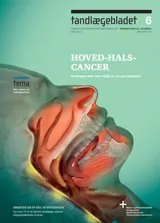Generelle udrednings- og behandlingsstrategier for hoved- og halscancer i Danmark
Karcinom i hoved-hals-regionen er en relativt sjælden form for kræft, som hvert år rammer ca. 1.300 patienter i Danmark. Medianalderen er ca. 60 år, og sygdommen er hyppigere hos mænd end kvinder. Blandt risikofaktorerne er tobaks- og alkoholforbrug, og i det seneste årti er forekomsten af humant papillomvirus relateret kræft i mund og svælg steget markant. Symptomerne omfatter sårdannelser, smerte, blødning, rumopfyldende proces, hæshed, lymfeknudesvulst på halsen mv. Den primære behandling af hoved-hals-kræft er operation eller strålebehandling, som monoterapi eller i kombination. Tumorer i svælg og strube behandles med primær strålebehandling; tumorer i øvrige lokalisationer med primær kirurgi og evt. postoperativ strålebehandling. Tidlig opsporing, hurtig diagnose og behandling uden ventetid er vigtigt for prognosen. Det kræver et stærkt samarbejde i sundhedsvæsenet, også med tandlæger. Med pakkeforløb for kræft er der sat retningslinjer for, hvordan sådanne hurtige forløb kan opnås. I artiklen gennemgås principper og praksis for disse forløb. De foreløbige resultater tyder på, at det er muligt at reducere den samlede udrednings- og behandlingstid betydeligt.
General strategies for diagnosis and treatment of head and neck cancer in Denmark
Carcinoma of head and neck region is a relatively rare form of cancer that annually affects about 1300 patients in Denmark. The median age is 60 years and the disease is more common in men than women. Among the risk factors are tobacco and alcohol consumption, as well as Human Papilloma Virus. In the past decade, the prevalence of HPV-related cancer of the mouth and throat increased significantly. Symptoms include ulceration, pain, bleeding, tumour, hoarseness, lymphadenopathy in the neck, etc. In 2008, accelerated clinical pathways were introduced for this condition. The primary treatment of head and neck cancer is surgery or radiation therapy, as monotherapy or in combination. Tumours of the pharynx and larynx are generally treated with primary radiotherapy, tumours in other localisations are managed with primary surgery, with postoperative radiotherapy if indicated. Early detection, prompt diagnosis and treatment without delay are important for prognosis. This requires a close collaboration between the medical and dental teams. This paper reviews the principles and practices for the diagnosis and treatment of head and neck cancer in such accelerated clinical pathways. Preliminary results suggest that it is possible to reduce the overall time from first contact with health care system to start of treatment.


